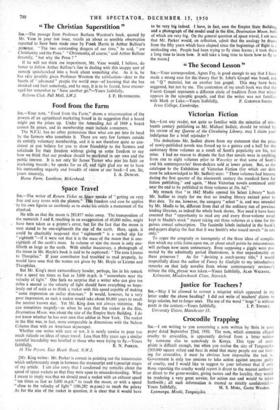Space Travel SIR.—The writer of „Return Ticket to ..;e .speaks
of "getting on very free and easy terms with the planets." Int freedom and ease he applies to his own figures so carelessly as to oialce:his article a monument of the slipshod.
He tells us that the moon is 283,857 miles away. The transposition of the numerals 3 and-8, resulting in an exaggeration of 45,000 miles, might have been taken as a printer's error, but for the fact that the moon is next stated to be one-eighteenth the size of the earth. Here, again, it could be charitably supposed that " eighteenth " is a verbal slip for
"eightieth "—if it were not that it is the mass of the moon that is one-
eightieth of the earth's mass. In volume or size the moon is only one- fiftieth as large as the earth. With similar inaccuracy, a photograph of
the moon in Mr. Hoyle's book is said to be captioned: "The area Livetus to Theopilus." If your contributor had troubled to read properly, he would have seen that the names are given by Mr. Hoyle as'Licetus and Theophilus.
But Mr. King's most extraordinary howler, perhaps, lies in his remark that a speed ten times as fast_ as 3,600 m.p.h. is "somewhere near the velocity of light." One feels no surprise that a writer who can give ten miles a second as the velocity of light should have everything so hope- lessly out of scale as to think a rocket with this speed capable of making
"some impression on stellar distances." It would, however, be a very poor impression, as such a rocket would take about 80,000 years to reach the nearest known star.. Yet Mr. King does not always minimise. He can Sometimes magnify—as when he says that the rocket in the film, Destination Moon, was about the size of the Empire State Building. I do not know whether he has ever seen that edifice in New York. The rocket in the film was, in fact, more comparable in dimensions with the Nelson Column than with an American skyscraper.
Whether one writes with care or not, it is surely unwise to pour too much ridicule on ideas of space travel. Less than fifty years ago a similar scornful incredulity was levelled at those who were trying to fly.—Yours
faithfully, E. N. PARKER. 14 The Pryors, East Heath Road, N.W3. ,
[Mr. King writes: Mr. Parker is correct in-pointing out the inaccuracies which unfortunately crept in between the manuscript and typescript stages of my article. I am also sorry that I condensed my remarks about the speed of space rockets so that they were open to misunderstanding. What I meant to imply was that we should need a rocket with an exhaust speed "ten times as fast as 3,600 m.p.h." to reach the moon, or with a speed "close to the velocity of light" (186,282 m.p.sec.) to reach the galaxy As for the size of the rocket in question, it is clear that it would have
to be very big indeed. I have, in fact, seen the Empire State Building, and a photograph of the model used in the film, Destination Moon, both of which are very big. On the general question of space travel, I am sure that Mr. Parker would, on reflection, admit that the analogy he draws from the fifty years which have elapsed since the beginnings of flight is a misleading one. People had been trying to fly since Icarus ; it took them a long time to learn how. It will take a long time to learn how to fly tu the moon.]






































 Previous page
Previous page